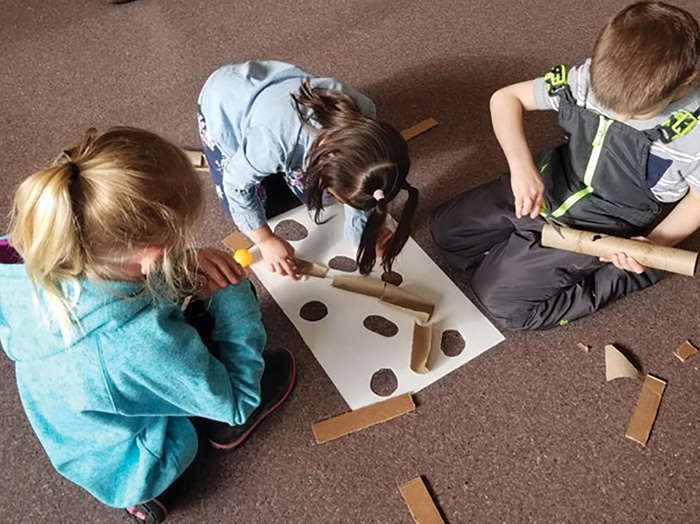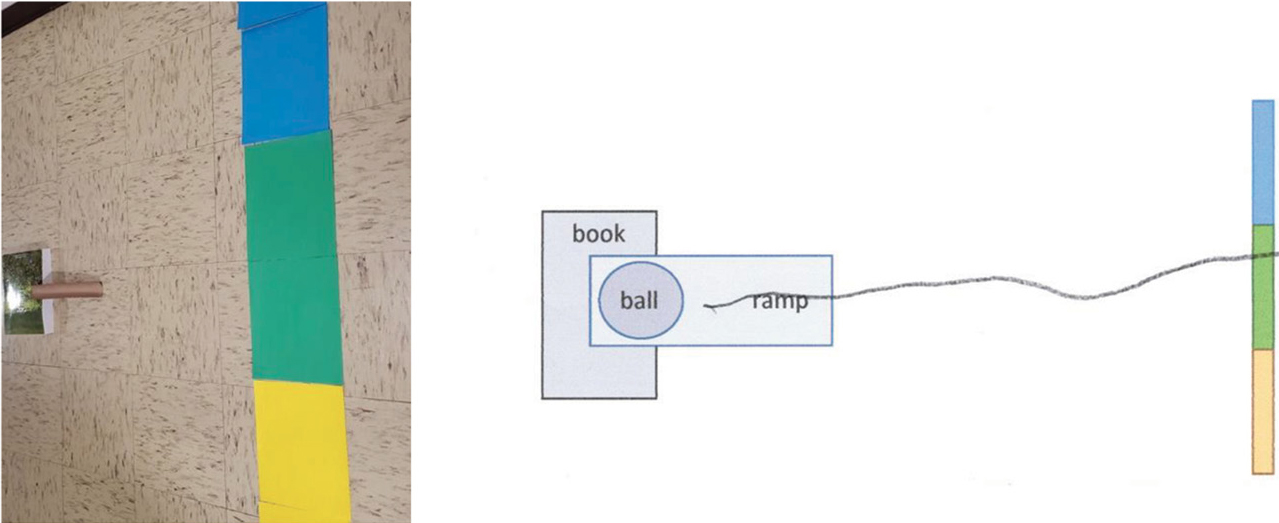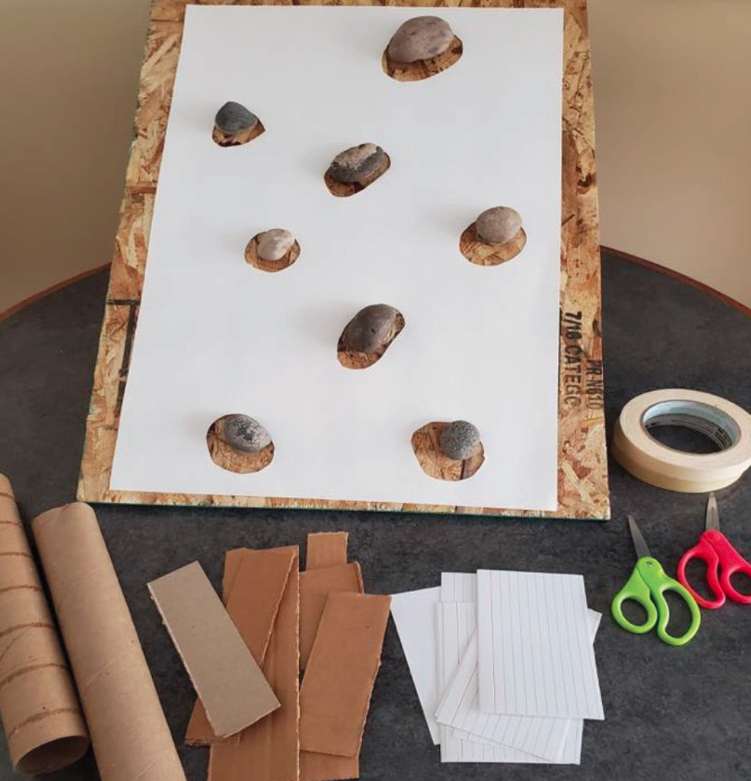Engineering Encounters
Engineering with Kindergarteners
A fun winter activity inspires an engineering challenge.
Science and Children—November/December 2021 (Volume 59, Issue 2)
By Rebekah Hammack and Tina Vo

Providing engineering opportunities for elementary students promotes a holistic approach to student learning around problem-solving, productive social interactions, and authentic science engagement. One of the more important aspects of engineering education allows for substantial content and context integration, providing students regardless of age with meaningful, concrete connections between the science topics they learn and the places they live. Educational research (Smith 2002) describes the importance of place-based education to bridge classroom learning experiences with students’ personal lives. Classroom activities should connect to a student’s location, culture, traditions, values, and personal experiences, allowing teachers to leverage the funds of knowledge (Moll et al. 1992) on which students innately rely.
This 5E lesson contextualizes engineering’s larger abstract ideas into a place-based activity for kindergarteners to consider their rural winter outdoor setting, allowing students to ask questions, design ideas, and analyze student-generated data to determine if a design solution works as intended to change an object’s speed or direction with a push or a pull (K-PS2-2, NGSS Lead States 2013). Additionally, we have outlined the teacher’s actions within the classroom and provided in italics additional considerations when transferring this idea into your classroom. Suggested times will vary based on student ability and attention spans. Teachers can break the lessons into multiple days as needed.
Engaging Students With a Place-Based Scenario (10 minutes)
This lesson began by supporting students to have an open discussion around the winter activities in their town, which highlighted the best sledding options available. To do this, the teacher first asked students to close their eyes and visualize winter coming into their town. After a moment by themselves, students were asked to share their favorite wintertime activities with their elbow partners and the group. This small and large-group discussion allows students to invest and frame their foundational knowledge within the future investigation. If students do not mention sledding, it is up to the teacher to bring in the idea themselves. Once the idea of sledding was introduced, the teacher presented a problem scenario to the students by reading aloud:
“There is a big hill near the town that the town council wants to make useful. The town’s people want to use it for a sledding hill. When taking a closer look at the hill, they discovered many big boulders spread across the hill. What do you think would happen if you were sledding down a hill with big boulders?”
After providing a problem scenario, it is important to end with a question that allows young students to consider the problem’s scope. Problem scoping will enable students to leverage their resources to define the problem, drive the design of their solutions, and add authenticity to the engineering process. The teacher invites students to discuss and brainstorm different outcomes. Some students made worried faces; others shouted, “it will flip over,” while more discussed how the sled “would get busted up.” Given these comments, the teachers framed safety as a theme by saying, “I’m hearing a lot of you talk about safety issues. That’s great we’re thinking about that. So when we’re thinking about solving the sledding hill problem, let’s keep safety in mind! You all brought up some great points, so what I’m hearing is that we need to design a sledding hill that is safe for people and sleds. I like that goal a lot.”
Supporting Students to Explore and Notice (15 minutes)
After the teacher articulated the goal of the problem, she transitioned by projecting a series of five images of sledding tracks so that all students could see and notice similarities, differences, and patterns in sled track design. The first projection had two sledding tracks, side-by-side, and she asked, “What do you notice?” Students’ responses included “twists and turns,” “there are curves,” “there are sides on the track.” The teacher engages students in deeper thinking by asking students, “Why are there curves? Why are there sides on the track?” It is essential to explore students’ ideas with this type of Socratic questioning, as it explicitly links student-generated ideas with the problem scenario and goal. Teachers should also begin highlighting structure and function ideas, pointing out that the structure of the track plays a role in how the people move on the track. The teacher continued the discussion by showing more images of sledding tracks to students, again asking them to explore each photograph and noticing additional structures (e.g., the height of the sides), writing down ideas on the board.
Once students had time to look and think about the different sledding tracks, the teacher redirected them back to the problem. “Now that we’ve seen a few successful sledding tracks people have designed for their area, we need to think about building a sledding track for our hill that will keep people safe. To do this, you might need a little more information.”
Explaining and Enacting Engineering Design with Models (20 minutes)
The standard K-PS2-2 asks that students “analyze data to determine if a design solution works as intended to change the speed or direction of an object with a push or a pull.” To do this efficiently, the teacher presented a demonstration, allowed students to explain ideas in their own words and consider how a structure could cause an object to change speed and/or direction. The teacher asked students to get out the worksheet (shared online; see Supplemental Resources) and pencils while she set up the basic materials, as shown in Figure 1.

Setup for first ramp demonstration and example student worksheet response.
First, she showed the students the ramp setup and said, “Alright, students, I want you to watch carefully and explain what you are seeing.” She placed the Ping-Pong ball at the ramp’s top, and gave it a small push forward. The Ping-Pong ball rolls over the green paper. “What happened? Write down what is happening. Where did the Ping-Pong ball go? Draw/model what you see” She encouraged them to include directional arrows to show which direction the Ping-Pong ball travels and had students share ideas and answers. Students should explain that the straight ramp will go into the green area. “It went straight” or “The Ping-Pong ball went into the green part.” Remember, do not tell the students this information; use student ideas and their words. By having students draw, explain, and modify their ideas around these different slopes and pathways, the teacher begins to lay the foundations of scientific modeling without explicitly addressing the concept with students.
Second, the teacher set up the ramp as shown in Figure 2, and said, “Now, I am going to release the Ping-Pong ball again, just like before, but this time, I have changed the shape of the ramp to curve. Watch what happens carefully.” She releases the Ping-Pong ball down the ramp, and it rolls over the blue paper. “What happened? Where did the Ping-Pong ball go? Why? Draw/model what you are seeing.” She encourages the students to add directional arrows to their paper to show the Ping-Pong ball’s new direction. Students should explain the curved ramp leads the Ping-Pong ball to cross into the blue area.

Setup for second ramp demonstration and example student worksheet response.
Next, the teacher told students, “Now, I want the Ping-Pong ball to roll across the yellow area. How do I change the shape of the ramp to do this?” She showed students the different curved pieces of cardboard and asked them to draw/model the ramp shape that will allow the Ping-Pong ball to cross the yellow paper. After a class discussion, she set up the ramp in the shape the students chose and tested it. If students did not write down an accurate pathway, allow them to redraw a more accurate path on a new sheet of paper or in a different color. Explain that “In science, we like to know what mistakes we make to help us in the future. So, it’s important to document/draw the right answer, but we shouldn’t erase old ideas.”
“Now that we’ve seen and explained how different shapes can change the direction of our Ping-Pong ball, even when we only push it forward, let’s take these ideas and see how they apply to our sledding track.”
Engineering and Evaluation (40 minutes)
The teacher reminded students of the scenario, re-reading the above passage. Then, she showed students a physical model of the hill, the supplies students could request, and a paper template that indicated where boulders were located (Figure 3). NOTE: Students should wear eye protection when testing the design as objects will be moving, and use safety scissors, as students will need to modify some of the materials. The teacher took a moment to explicitly discuss safety with the students. She also reminded students about safety concerns and behaviors with scissors, and respectful classroom conduct. Students could return and request materials as needed. The teacher gave the following parameters:

Materials for sledding hill designs.
- The sledding track had to use multiple materials (minimum three)
- The sledding track had to be open-topped to provide the sledder with the best views.
First, the teacher placed students into groups of three to support student discussion and perspective taking. She allowed students of different ability levels to group, focusing more on communication and collaboration styles of the kindergarteners. In their groups, students drew up their idea on the design paper template. The teacher walked around to groups, listening to conversations and asking probing questions like, “How many twists and turns will there be?” “What direction is your path going?” “Do you think the Ping-Pong ball can go up the hill?” “Do you think your Ping-Pong ball can fit through there? Yes? Okay, give it a try, but make sure to watch what happens carefully.” Allow students to make their own mistakes and direct their attention to where the errors might occur. These questions will continue throughout the next steps, as well. Asking probing questions is an important piece to encourage young students to engage with engineering design. Similar questions will occur in each of these steps, and the repetition will support students to recognize patterns in the process from development to testing.
Second, students requested supplies using their drawings/paper models. The teacher ensured students thought about their sledding track’s shape and design and documented their ideas on paper. She also checked that requested materials matched students’ paper model. The teacher might ask the questions listed above, and additionally, “What materials do you want to use and WHY do you want to use them?” “Have you thought about how much you need?” “This is a big twist in your paper model. Are you using the same or different materials for this twist?”
To be more authentic to engineering, students must be given a flexible idea of the engineering design process. Engineers do not have a singular linear method to follow. Instead, they engage in an iterative process during which they plan, model, test, and improve incrementally toward an outcome that meets the criteria of the problem they are addressing. The next piece of this lesson happened iteratively and concurrently, allowing students to (a) request materials, (b) build parts of their model sledding track, and (c) improve their design based on testing and documentation. Students in different groups were allowed to be at different stages at other times. The teacher provided structure by asking student groups probing questions that needed to be answered when moving among these stages. For example, a student’s sledding track caused the Ping-Pong ball to get stuck in the first turn, and the student requested more materials. The teacher asked, “Why do you think the ball got stuck? What did you notice about the way it moved? What could you change about your design to fix this? Talk with your group and draw out a new design, and once you have that, we’ll get you more supplies.” This process continued until students developed a finalized sled track for testing. As students move through this iterative process, teachers should highlight the cause and effect and the structure and function of the materials and their design. This explicit questioning ensures that the crosscutting concept pieces of standard K-PS2-2 AND K-2ETS1-2 are met.
As the teacher was walking around the classroom, she continued to ask, “What do you notice? What do you wonder?” and allowed students to continue exploring until most students have at least one functional track. She asked students to end the project by sharing their “best” design and describing the ideas of the group. The teacher then guided a large group discussion around peer assessment by asking students to raise their hand if the group’s sledding track met the criteria and constraints by asking:
- Can you see that this group has used at least three different materials?
- Do you think the top of the track is open?
- Did the Ping-Pong ball miss all the rocks?
Engineering opportunities like this allow students to engage with intentional design challenges situated within familiar contexts. As students build science content and practice in tandem with engaging engineering design, teachers provide a structured yet complex experience appropriate for younger students. ●
Supplemental Resources
Download the modeling sheet and self-assessment at https://bit.ly/3C27SHZ.
Rebekah Hammack (rebekah.hammack@montana.edu) is an assistant professor of science education at Montana State University in Bozeman. Tina Vo is an Aassistant professor of science/STEM education at the University of Nevada-Las Vegas.


